
In the above equatio is a scale changed form of the
International Journal of Scientific & Engineering Research, Volume 6, Issue 2, February-2015 1231
ISSN 2229-5518
Image Edge Detection by combining Fuzzy Logic
Behzad Ebrahimnezhad sani,Mohamad Amin alikhani, Javad Haddadnia
Abstract— Edge detection in digital images is one of the most important issues in image processing and it can be solved by different methods. Most of these methods can be combined with fuzzy systems. In this paper, an algorithm is proposed in which the input of applying wavelet transform at input image and the image obtained by applying a high-pass filter on the image are given to a first order fuzzy system. And based on fuzzy logic, it is decided about the probability of being edge of each pixel of the image. The results obtained by this method were compared with the results of well-known methods of edge vector. And these results show a better performance in images
Index Terms—edge detection, Wavelet transformation, fuzzy system
—————————— ——————————
Since the number of edges states the object forms of an image and as a result is provides many information about the image. Edge detection is so important in image processing. By using edge detection, the high volume of image is reduced and the image is prepared to a high level processing such as Pattern recognition. The edge detection algorithms are divided into three major groups which are included spatial method, fre- quency method and spatial-frequency method. In spatial methods, edge detection algorithms are divided into two groups. In the first group, the first derivative of the image is used. The algorithms of Sobert, Proyet, Robert are included in this categories. In the second category, first derivative of the image is used and by using zero crossing property, the place of edges is detected, for example, Laplace edge identifier is this category. Modern methods are also provided based on fuzzy method to edge detection. And in this method, the neighbors points of image are considered as categories and by using appropriate membership functions which are defined, fuzzy inference system is implemented, for example in [4], threshold limit value in edge detection is calculated by using fuzzy system. In [5], by considering neighborhood points as
3*3 sets around core points and defining membership prede- fined functions and creating 5 method to detecting color dis- continuities in each category, edge detection is done. In [1], the adjacent points of each image are considered in 6 set and by using membership functions, a convenient value between 0 and 1 is determined for each category and based on member- ship degree of each category and using fuzzy rules, the fuzzy base system is used for decision making about the presence of edge and its direction. Among new methods in this context are
based on these methods solve the problems related to edge detection and edge position but it is so sensitive due to high- pass features. Dyadic Wavelet transformation is an appropri- ate method to show the signal as a multi- resolution signal. There are many articles about information combination ob- tained by image wavelet transformation which are provided in different scales. For example, Mallat has obtained necessary information about edge detection based on local maximum of the size of wavelet transformation. [6] xu was doing edge de- tection based on sharing the edge detection with Wavelet transformation and also he had shown that that by selecting an appropriate wavelet based on the edge type in presence of noise, we will have a better edge detection [7]. Zhang and bao had used overall maximum of wavelet transformation scales to detect important signal edges. [2] generally, all articles which have used multi-dimensional image, tried to find an accurate edge detection, but we can not generalized a method which can be used for all images.
This article is composed of following sections, in second sec- tion of this article, wavelet transformation and fuzzy logic are used. In third section, the proposed approach and the ob- tained results are provided. Summarization and comparison are conducted in forth section and fifth section is dedicated to conclusion.
In this section, we investigate the applied wavelet transfor- mation in thus article and initial definitions of Fuzzy Logic.
multi-resolution based methods. [5]. Although the approaches
————————————————
1-Master student of electronic Engineering, Hakim Sabzevari University
2- Master student of electronic Engineering, Hakim Sabzevari University
3-Associate Professor of Biomedical Engineering, Hakim Sabzevari Univer-
Wavelet transformation of a signal f
by the following equation:
∈ L2 (R)
is determined
sity

In the above equatio is a scale changed form of the
function ψ ∈ L2 (R)
IJSER © 2 ![]() http://www.ijser.org
http://www.ijser.org
and it is defined as
International Journal of Scientific & Engineering Research, Volume 6, Issue 2, February-2015 1232
ISSN 2229-5518
There are many wavelet transformations and continuous wavelet transformation is obtained by the following equation
is called membership function. In deterministic sets, member- ship function only has two value in its range that this two el- ements are yes or no ( one, zero), there are two possible value in a classic tw0value logic. So:![]()
In the above equation x(t) is an input and wavelet and a is position and b is scale.
ψ (t ) is mother
In which ![]() is the membership function of element x in A
is the membership function of element x in A
This continuous wavelet transformation has discontinuous coefficients and it used a power 2 scale. In many articles, this type of transformation is used as discontinuous wavelet, di-
rectly. In this transformation, softener function![]() which its
which its
integral is zero and it converges to zero. Wavelet function
![]() is defined as and they are calculated in scales which are power of 2. So, dyadic mother wavelet func- tion is defined as and wavelet transformation of the f(x) function is defined as follows:
is defined as and they are calculated in scales which are power of 2. So, dyadic mother wavelet func- tion is defined as and wavelet transformation of the f(x) function is defined as follows:
(3 
In this section, we investigate two-dimensional wavelet detec- tion. For this purpose, two-dimension softener functions are used. First, two wavelet functions are used in this article and we investigated them. First function is a partial derivative of a
deterministic set. Fuzzy systems are described by a set of lin- guistic sets based on expert knowledge. And it includes 4 fuzzifiers section, knowledge base, inference engine and de- fuzzifier. In a fuzzy system, knowledge base includes basic data and basic statements. Basic data include a set of member- ship functions and input-output variables.
And it produces necessary information for the performance of fuzzifier section, inference engine, anddefuzzufier. The fuzzi- fier produces input deterministic signals by using fuzzy set theory to fuzzy signals which are linguistic variables. Fuzzy inference engine transforms the situation from input to out- put, by using fuzzy rules and finally it transforms the de- fuzzfier of fuzzy outputs to clear and deterministic control signals.
In this section, we investigate the proposed method of this article in edge detection, first, we detect the inputs of fuzzy system. First input of fuzzy system is an image that its discon-![]()
two-dimensional softener function
θ (x , y )
along with x
tinuous wavelet is obtained by an algorithm which is provid-![]()
pivot and second function is a partial de
rivative along with y pivot . The function of s
ed in article [7]. Obtained picture can considers noise and arbi- trary resolution due to the selected scale. If the scale is bigger,
is defined in two functions ofψ 1 (x , y ),ψ 2 (x , y )
tions 4 , 5.
by equa-
the width of mother wavelet is bigger and as a result, frequen- cy separation is getting worse but it creates a better time reso- lution. In this article, we use scale 2 for discontinuous wavelet. To determine first input in scale2, we obtain the following statement.
M f (x , y ) =
![]()
(((w 1f (x , y ))2 + (w 2 f (x , y ))2 ) (7)
Where
s = 2 j , j ∈ z , j ∈ (−∞, +∞)
The wavelet of signal f is defined as
s s s
W 1f
(x ) = f
*ψ 1 (x , y ) and.W 2f
(x ) = f
*ψ 2 (x , y )
s s s s
Fuzzy logic believes that ambiguity is in the science nature.
Deterministic sets are natural and normal sets which are de-
fined first of set classic theorem. Adding deterministic proper-
ty creates a distinction aspect and by using it creates one of the
critical and innovative concepts in fuzzy logic in mind which
IJSER © 2015 http://www.ijser.org
International Journal of Scientific & Engineering Research, Volume 6, Issue 2, February-2015 1233

ISSN 2229-5518
 D)
D)
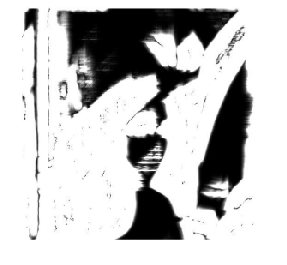
A)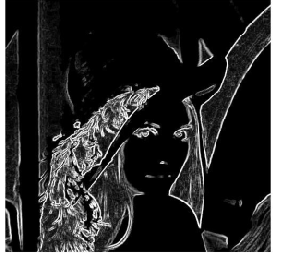
E)
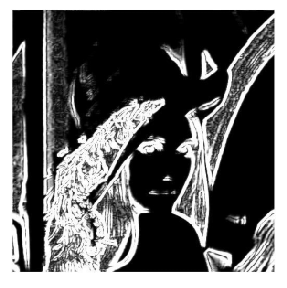
B)
Figure 1: A) original image of Lena and B, C, D, E) edge taken images of lena with wavelet in different scales.
The size of obtained wavelet function from equation 7 is calcu- lated for different scales. Membership functions for first input of fuzzy system are shown in figure 2 and they are obtained by experiment and trial and error method.
Another input of fuzzy system is the result of applying high- pass filter matrix on digital image. The feature of high-pass filter is to find points in the image which have high frequency; edges are points that their frequency is high. The stated matrix is a high-pass matrix. And due to the sensitivity range to edge, we can change its coefficients. Membership functions are shown for the second input of fuzzy system in figure 4 and these membership functions are obtained by using experiment and trial and error method.Figure 3 is the obtained image by applying high-pass filter on the lena image. (figure 1 from 1)
C)
IJSER © 2015 http://www.ijser.org
International Journal of Scientific & Engineering Research, Volume 6, Issue 2, February-2015 1234

ISSN 2229-5518

Figure 4: membership functions of second input of fuzzy sys- tem obtained by applying high-pass filter on picture.
Figure 2: membership function of wavelet input of fuzzy sys- tem
Figure 3: obtained image by using high-pass filter on lena pic- ture
Obtained inputs are given to Mamdani fuzzy system and the output is obtained based on membership function of figure 5. These membership functions are obtained based on trial and error experiment. Figure 1 shows the rules of conducted fuzzy system.
Figure 5:output membership function to edge detection of a picture
Finally, we can use threshold to extenuate the obtained edges.
IJSER © 2015 http://www.ijser.org
International Journal of Scientific & Engineering Research, Volume 6, Issue 2, February-2015 1235
ISSN 2229-5518
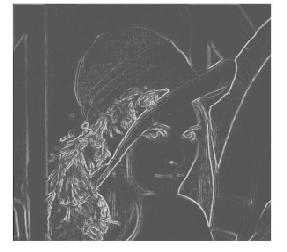
The proposed algorithm is done on Matlab software. Since there is no specific method to detect performance and priority of proposed algorithms except visual method, proposed method can be run on a number of images and we compared the obtained results by using Priot method by traditional edge detection methods. In figures 6,7, the results of proposed method and priot method [1] are shown on lena and camera man pictures. Obtained images show that proposed method has a hogher performance in edge detection than priot method. By using threshold level, we can reduce the edge width
C)
Figure 6: A)original picture, B) edging by priot and C) edging by proposed algorithm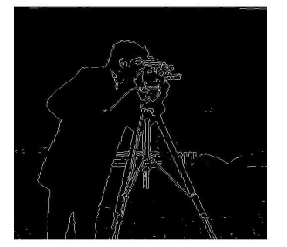
A) 
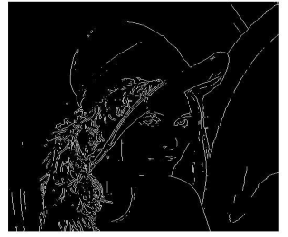 A)
A)
B)
B)
IJSER © 2015 http://www.ijser.org
International Journal of Scientific & Engineering Research, Volume 6, Issue 2, February-2015 1236
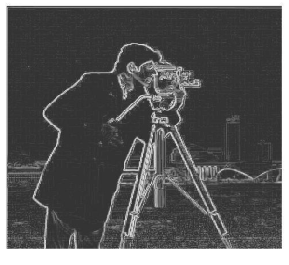
ISSN 2229-5518
C)
Figure 7: A)original picture, B) edging by priot and C) edging by proposed algorithm
5 CONCLUSION
Edge detection plays an important role in image processing since its implementing success ensures the success on other stages of image processing. The proposed method in this article is a combi- nation method of two methods of edge detection with wavelet and fuzzy system and it includes the advantages of two methods. Also, by selecting appropriate scale, we can reduce noise and on the oth- er hand, by using fuzzy logic against ambiguities and image opaque which can be problematic for edging and by this, we can
increase the performance of edge detection.
[1] Afsari, Fateme, a new fuzzy edge finder by using dynamic member- ship functions, Iran fuzzy system association, 1383.
[2] L. Zhang and P. Bao, “Edge detection by scale multiplication in
wavelet domain”, Pattern Recognition Letters, Vol. 23, No.
14,December 2002, pp. 1771-1784.
[3] S. Wang, F. Ge, T , Liu, Evaluating Edge Detection through Boundary Detection,Department of Computer Science and Engineer- ing, Univercity of south Carolina,Columbia, Usa, 2006.
[4] M. Zhao ,A. M .N .Fu ,h. Yan,a technique of three Level Threshold-
ing Based on Probablity Partition an Fuzzy 3-Partition , IEEE Trans on Fuzzy System,vol.9,no.3, pp.469-479, June 2001.
[5] L.R Liang,C.G. Looney,"Competitive fuzzy edge detection
",Applied Soft Computing, accepted 23 january 2003.
[6] S. Mallat, “A theory for multi-resolution signal decomposition”, IEEE Trans. Pattern Anal.Machine Intell., Vol. 11, pp. 674-69IEEE Trans. Image Processing, Vol. 3, pp.747-758, 1994.344
[7] S.Mallat,"Characterization of signals from Multiscale Edg- es,"IEEE.Trans.Patt .Anal. Machine intell.,vol.PAMI-14,PP.710-
732,1992
[8] Y. Xu et al, “Wavelet transform domain filters:a spatially selective noise filtration technique”,
IJSER © 2015 http://www.ijser.org